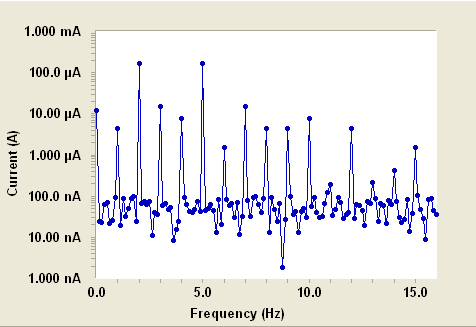Basics of Electrochemical Frequency Modification
Technique
Electrochemical Frequency Modulation (EFM) is a nondestructive corrosion-measurement technique that can directly give values of the corrosion current without a priori knowledge of Tafel constants. Like Electrochemical Impedance Spectroscopy (EIS), EFM is a technique using small AC signals. Unlike EIS, however, two sine waves (at different frequencies) are applied to the cell simultaneously. Because current is a non-linear function of potential (see Butler-Volmer), the system responds in a non-linear way to the potential excitation. The current response contains not only the input frequencies, but also contains frequency components which are the sum, difference, and multiples of the two input frequencies.
The theory is beyond the scope of this introduction. However, this non-linear response has been shown to contain enough information about the corroding system so that the corrosion current can be calculated directly.
The two frequencies may not be chosen at random. They must both be small, integer-multiples of a “base frequency” that determines the length of the experiment. The figure below shows the waveform when the two input frequencies are 2 Hz and 5 Hz. The base frequency was 1 Hz, so the waveform repeats after 1 second.

The higher frequency must be at least twice the lower one. The higher frequency must also be sufficiently slow that the charging of the double layer does not contribute to the current response. Often, 10 Hz is a reasonable limit.
The current response is measured and processed. The result is a spectrum of current response as a function of frequency. The spectrum is called the “intermodulation spectrum” (see example below). The two large peaks, with amplitudes of about 200 µA, are the response to the 2 Hz and 5 Hz excitation frequencies. Those peaks between 1 µA and 20 µA are the harmonics, sums, and differences of the two excitation frequencies. The Electrochemical Frequency Modulation analysis script uses these peaks to calculate the corrosion current and the Tafel constants. Between the peaks the current response is very small. There is nearly no response (<100 nA) at 4.5 Hz, for example.

The frequencies and amplitudes of the peaks are not coincidences. They are direct consequences of the EFM theory.
Calculating the Corrosion Current and the Corrosion Rate
Taking the example above, a Base Frequency of 1 Hz is used together with MultiplierA = 2 and MultiplierB = 5. The table below shows the calculation of the frequencies used in the EFM calculation and the amplitudes expected. In the excitation waveform, 2 Hz and 5 Hz are present with equal amplitudes so it is not much of a surprise that the current response at these two frequencies should be equal.
| Multiplier | Value | Frequency/Hz | Amplitude |
|---|---|---|---|
| A | 2 | 2 | a |
| B | 5 | 5 | a |
| B – A | 5 – 2 | 3 | b |
| B + A | 5 + 2 | 7 | b |
| B – 2A | 5 – 2(2) | 1 | c |
| 2B – A | 2(5) – 2 | 8 | c |
| B + 2A | 5 + 2(2) | 9 | c |
| 2B + A | 2(5) + 2 | 12 | c |
| 2A | 2(2) | 4 | d |
| 2B | 2(5) | 10 | d |
| 3A | 3(2) | 6 | e |
| 3B | 3(5) | 15 | e |
The five constants, a to e, depend on the type of corrosion taking place. The equations below are valid if both the anodic and cathodic processes are activation- (kinetically) controlled. Very similar equations can be derived for the case of a passive metal, or for a diffusion-controlled cathodic process.
| Amplitude | Value for Activation Control of Corrosion |
|---|---|
| a | icorr[V/ba + V/bc] |
| b | (1/4) icorr [(V/ba)2 – (V/bc)2] |
| c | (1/24) icorr[(V/ba)3 + (V/bc)3] |
| d | (1/2) icorr[(V/ba)2 – (V/bc)2] |
| e | (1/8) icorr[(V/ba)3 + (V/bc)3] |
where ba, bc = Tafel constants, volt / loge unit; V = excitation amplitude, in volts
The value of icorr can be calculated from the measured amplitudes a, b, and c. Values of ba and bc can also be calculated. The corrosion rate can be obtained directly from the value of icorr.
Causality Factors
The great strength of the Electrochemical Frequency Modulation technique is that, according to EFM theory, the ratio of the constant b to d should not depend on corrosion rate or Tafel constants. The ratio d/b is given the name “Causality Factor 2” because that ratio is 2.0! Likewise, the ratio e/c should be equal to 3.0, and is given the name “Causality Factor 3”. These Causality Factors serve as an internal check on the validity of the EFM measurement!

Comments are closed.